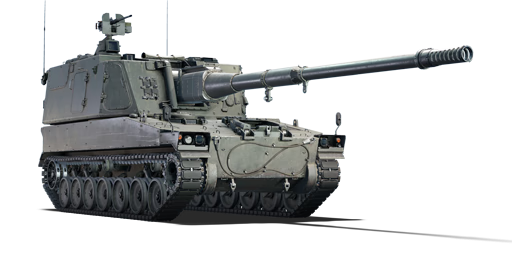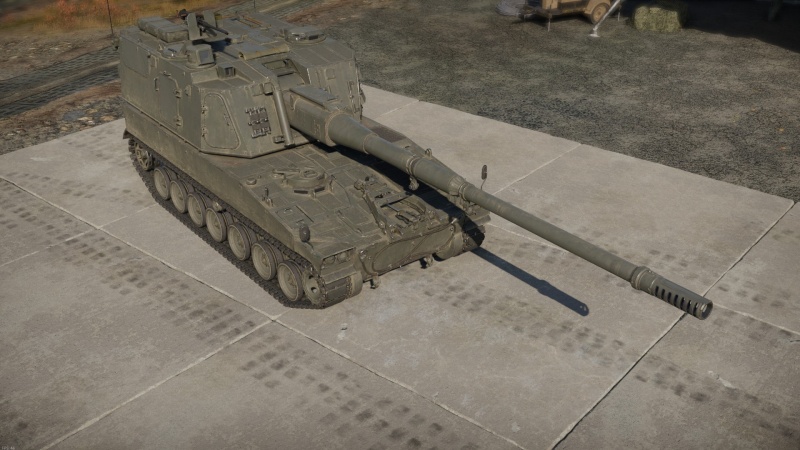Type 99
Contents
Description
The Type 99 155 mm SPH (99式自走155mmりゅう弾砲) is currently one of the 155 mm howitzers in JGSDF service as the direct replacement of the obsolete, shorter-barreled Type 75 155 mm SPH. The JGSDF had already planned for a replacement of the Type 75 SPH as early as 1985; development began in 1987, with MHI responsible for the extended hull based on the chassis of what would become the Type 89 IFV, while JSW developed the weapon systems with a domestic 155 mm L/52 howitzer. The new SPH was ready for trials in 1996, and tests were conducted in 1998, with the first four SPH units delivered to the training corps. However, due to the high unit price, the complete replacement of all Type 75 SPHs will be fulfilled by the Type 99 SPH alongside a new, wheeled Type 19 155 mm SPH.
Introduced in Update "Air Superiority" as the second SPH of JGSDF, the Type 99 is equipped with a Japanese NATO standard 155 mm howitzer and shares similar shells, but due to the increased length, it offers a whopping 940 m/s shell velocity. The new gun system retains the relatively fast gun traverse speed and new autoloader for faster reload; meanwhile, players have to beware of the rather underpowered engine and huge size; enemy commanders can easily spot this long-nosed "lying Pinocchio" from afar.
- Nicknames
- JGSDF Abbreviation: 99HSP / SP - (Howitzer) Self-Propelled
- Public nickname: ロングノーズ - Lit. "Long Nose"
General info
Survivability and armour
Instead of opting for NATO SPHs, the JGSDF initiated plans to develop a domestic SPH, resulting in the creation of the Type 99. The most distinctive feature of the Type 99 is its notably long 155 mm L/52 howitzer, contrasting with the short chassis based on the Type 89 IFV. This characteristic earned it the nickname "Long Nose." However, this length poses a challenge as it makes the Type 99 easily identifiable on the battlefield. With an overall length, including the barrel, measuring 11.3 m, it cannot move unnoticed unless enemies are overly focused on a specific area. The overall protection comprises 20 mm RHA plates for both the chassis and turret. This means that any .50 calibre heavy machine gun won't struggle to target the crews within 300 m, let alone autocannons at even longer ranges. Taking cover and staying behind the line is advisable to prolong its service life. Extra caution is needed to conceal the rear of the turret, as the last thing players want is to witness the detonation of the 30 shells located directly behind it, creating a significant explosion nearby.
Equipped with a mechanized loader, the Type 99 operates with a smaller crew than NATO/Warsaw Pact SPHs, numbering only four individuals. Out of these, three crew members are situated on the right-hand side of the vehicle. Consequently, tank shots aimed at the driver have a high probability of knocking out enough crew members to disable the vehicle permanently. Shots with explosive fillers also pose a serious threat, causing lethal damage to the turret crew upon penetration.
Armour type:
| Armour | Front (Slope angle) | Sides | Rear | Roof |
|---|---|---|---|---|
| Hull | 20 mm UFP (80°)
20 mm LFP |
20 mm Top 20 mm Bottom |
20 mm | 20 mm |
| Turret | 20 mm Turret front 20 mm Gun mantlet |
20 mm | 20 mm | 20 mm |
Notes:
Mobility
As the hull was developed from Mitsubishi's Type 89 IFV with an extended length, the Type 99 retained the identical 6SY31WA V8 engine and transmission. While the 50 km/h speed and its 12.1 hp/t ratio might not seem particularly impressive, it does offer a -30 km/h reverse speed for a quick retreat.
| Game Mode | Max Speed (km/h) | Weight (tons) | Engine power (horsepower) | Power-to-weight ratio (hp/ton) | |||
|---|---|---|---|---|---|---|---|
| Forward | Reverse | Stock | Upgraded | Stock | Upgraded | ||
| Arcade | 54 | 33 | 40 | _,___ | 1,145 | __.__ | 28.63 |
| Realistic | 50 | 31 | _,___ | 600 | __.__ | 15 | |
Modifications and economy
Armaments
Main armament
To align with the late Cold War trend of self-propelled howitzers featuring long barrels, the Type 99 is equipped with a domestic 155 mm L/52 howitzer by JSW. The gun system boasts 30 shells in storage with an autoloader, enabling a firing rate of one shot every 7.5 seconds. Although not as rapid as the Bkan 1C at 3.2 seconds, this rate is more than sufficient for engaging tanks at its tier, which typically have longer reload times. The ballistics remain relatively straight due to its impressive 940 m/s velocity, facilitating easier long-range engagements. An area where the Type 99 excels is a supporting role.
However, caution is advised to avoid overextension, especially with the barrel exposed behind cover, as this may lead to the gun's disablement and, eventually, the Type 99 itself.
| 155 mm JSW L/52 | Turret rotation speed (°/s) | Reloading rate (seconds) | ||||||||
|---|---|---|---|---|---|---|---|---|---|---|
| Mode | Capacity | Vertical | Horizontal | Stabilizer | Stock | Upgraded | Full | Expert | Aced | Autoloader |
| Arcade | 30 | -2°/+70° | ±180° | - | __._ | __._ | __._ | __._ | __._ | 7.5 |
| Realistic | __._ | __._ | __._ | __._ | __._ | |||||
Ammunition
- M107: NATO standard 155 mm HE shell, providing a reasonable 9.1 kg TNTe explosive mass.
- M107(PF): M107, but equipped with a proximity fuse. The excellent velocity of the L/52, coupled with the proximity fuse, makes it a versatile ad-hoc AA shell.
- L15A2: The pinnacle of NATO 155 mm shells, it offers an impressive 14.8 kg TNTe explosive mass. It has the potential to obliterate even the most heavily armoured vehicles.
- M110: NATO Standard 155 mm Smoke shell.
| Penetration statistics | |||||||
|---|---|---|---|---|---|---|---|
| Ammunition | Type of warhead |
Penetration @ 0° Angle of Attack (mm) | |||||
| 10 m | 100 m | 500 m | 1,000 m | 1,500 m | 2,000 m | ||
| M107 | HE | 61 | 61 | 61 | 61 | 61 | 61 |
| M107 (PF) | HE-VT | 61 | 61 | 61 | 61 | 61 | 61 |
| L15A2 | HE | 64 | 64 | 64 | 64 | 64 | 64 |
| Shell details | ||||||||||||
|---|---|---|---|---|---|---|---|---|---|---|---|---|
| Ammunition | Type of warhead |
Velocity (m/s) |
Projectile mass (kg) |
Fuse delay (m) |
Fuse sensitivity (mm) |
Explosive mass (TNT equivalent) (kg) |
Ricochet | |||||
| 0% | 50% | 100% | ||||||||||
| M107 | HE | 940 | 43.1 | 0.3 | 0.1 | 9.14 | 79° | 80° | 81° | |||
| L15A2 | HE | 940 | 43.5 | 0.3 | 0.1 | 14.8 | 79° | 80° | 81° | |||
| Proximity-fused shell details | ||||||||||||
|---|---|---|---|---|---|---|---|---|---|---|---|---|
| Ammunition | Type of warhead |
Velocity (m/s) |
Projectile mass (kg) |
Fuse delay (m) |
Fuse sensitivity (mm) |
Arming distance (m) |
Trigger radius (m) |
Explosive mass (TNT equivalent) (kg) |
Ricochet | |||
| 0% | 50% | 100% | ||||||||||
| M107 (PF) | HE-VT | 940 | 43.1 | 0 | 0 | 300 | 3 | 9.14 | 79° | 80° | 81° | |
| Smoke shell characteristics | ||||||
|---|---|---|---|---|---|---|
| Ammunition | Velocity (m/s) |
Projectile mass (kg) |
Screen radius (m) |
Screen deploy time (s) |
Screen hold time (s) |
Explosive mass (TNT equivalent) (g) |
| M110 | 940 | 40.8 | 21 | 5 | 30 | 50 |
Ammo racks
| Full ammo |
1st rack empty |
2nd rack empty |
3rd rack empty |
4th rack empty |
5th rack empty |
6th rack empty |
Visual discrepancy |
|---|---|---|---|---|---|---|---|
| 30 | __ (+__) | __ (+__) | __ (+__) | __ (+__) | __ (+__) | __ (+__) | __ |
Machine guns
Offensive and anti-aircraft machine guns not only allow you to fight some aircraft but also are effective against lightly armoured vehicles. Evaluate machine guns and give recommendations on its use.
| 12.7 mm M2HB | ||||
|---|---|---|---|---|
| Mount | Capacity (Belt) | Fire rate | Vertical | Horizontal |
| ___ (___) | ___ | __° | __° | |
Usage in battles
Describe the tactics of playing in the vehicle, the features of using vehicles in the team and advice on tactics. Refrain from creating a "guide" - do not impose a single point of view but instead give the reader food for thought. Describe the most dangerous enemies and give recommendations on fighting them. If necessary, note the specifics of the game in different modes (AB, RB, SB).
Pros and cons
Pros:
- Excellent shell velocity of 940 m/s (for a SPH)
- Can make the M107 (PF) a reliable AA shell
- 7.5-second auto-loader
- 30 shells in the ready rack
- 20 mm RHA armour offers a balance of protection without excessive weight
- Thin enough to avoid triggering most APHE fuses
- Effective protection against HMGs at longer ranges
- Moderate mobility with a respectable -30 km/h reverse speed
Cons:
- Limited protection with 20 mm RHA armour
- Minimal defense against shell penetration
- In close-quarter combat, vulnerable to heavy machine guns
- Relatively small crew size
- Large and easily recognizable target
- Very long barrel can be exposed when positioned behind cover
History
Describe the history of the creation and combat usage of the vehicle in more detail than in the introduction. If the historical reference turns out to be too long, take it to a separate article, taking a link to the article about the vehicle and adding a block "/History" (example: https://wiki.warthunder.com/(Vehicle-name)/History) and add a link to it here using the main template. Be sure to reference text and sources by using <ref></ref>, as well as adding them at the end of the article with <references />. This section may also include the vehicle's dev blog entry (if applicable) and the in-game encyclopedia description (under === In-game description ===, also if applicable).
Media
Excellent additions to the article would be video guides, screenshots from the game, and photos.
See also
- Related Development
- Other vehicles of similar configuration and role
External links
Paste links to sources and external resources, such as:
- topic on the official game forum;
- other literature.
| Japan tank destroyers | |
|---|---|
| Ro-Go Derivatives | Ro-Go Exp. |
| Chi-Ha Derivatives | Ho-Ni I · Ho-Ni III · Ho-Ro · Chi-Ha LG |
| Ho-Ri | Ho-Ri Prototype · Ho-Ri Production |
| Other | Na-To |
| JGSDF | |
| SPRG | Type 60 (C) |
| SPH | Type 75 · Type 99 |
| ATGM | Type 60 ATM |
| Rocket | Type 75 MLRS |
| USA | ▅M36 |





